The Microsoft Surface Laptop 3 Showdown: AMD's Ryzen Picasso vs. Intel's Ice Lake
by Brett Howse & Andrei Frumusanu on December 13, 2019 8:30 AM ESTGPU Performance - Vega vs Iris
After many tests, it is very clear that Intel’s Ice Lake platform offers a significantly faster CPU, and the results were unsurprising. Although the Ryzen Mobile 3000 platform did launch in 2019, it already struggled on CPU tests against the older Skylake core processors. But on the GPU side, Intel is the one that needs to play catch-up. Previous to Ice Lake, Intel’s standard GT2 GPU platform, found on almost all U-Series 15-Watt processors, offered 24 execution units of their Gen 9.5 GPU. AMD squeezed their Vega GPU architecture into their Ryzen SoC, which could easily double the performance of the Gen 9.5 GT2 GPU.
Ice Lake is Intel’s first real attempt to make a powerful iGPU a standard feature for their CPUs, although it is only a first step. But the new Gen 11 architecture brings some improvements such as more advanced tile-based rendering, variable rate shading, and of course the LPDDR4X-3733 memory adding significant bandwidth, greatly helping the GPU. The biggest change though is just how much die space Intel has dedicated to graphics, jumping from 24 EUs on a full GT2 to 64 EUs on a full GT2 part such as the Core i7-1065G7. And, following in AMD’s footsteps again, Intel is offering cut-down GPUs on lower-spec processors. It’s confused their already confusing processor naming, but the lowest-spec Core announced so far still has 32 EUs, meaning it is still better than the previous gen even at the “G1” level.
AMD has some tricks up their sleeves as well. For the Surface Laptop 3, Microsoft requested a slightly more powerful configuration for their Surface-branded processor. While the CPU side matches the same specifications as the non-Surface CPUs, Microsoft's processor SKUs add an extra GPU Compute Unit to both its Ryzen 5 and Ryzen 7, bringing them to 9 and 11 respectively. So the Surface Laptop 3 should be the best possible showcase for GPU performance on the 3000 series Ryzen mobile APU.
Before the results, let’s go over the driver situation. The Intel system ships with an updated driver over what we used on the Dell XPS 13 2-in-1, which resolves the 3DMark issues we saw on that laptop. The driver is from 2019-11-06 and is version 26.20.100.7463. The AMD platform’s driver is from 2019-10-07 and is version 26.20.12027.5004. Unfortunately, the AMD driver can’t be updated from AMD directly, and instead will be released by Microsoft. The current driver has some quirks, so an updated driver is needed for usability, but it did not prevent any GPU workloads from being run. But, the AMD system would only output 1280x720 where we normally test at 1366x768, and attempts to output to an external monitor were thwarted by the buggy driver, so be aware that in most of the gaming tests, the AMD system was outputting at a slightly lower resolution.
Let’s see how the do starting with some synthetics, and then moving to some real-world games.
3DMark
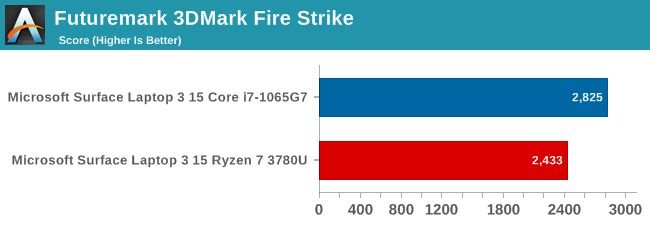
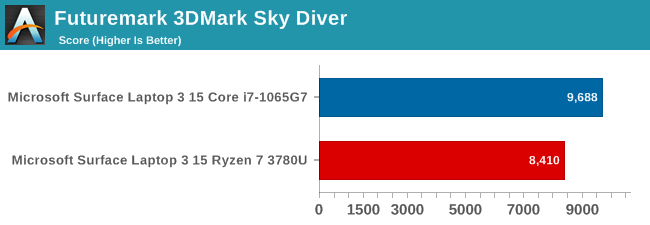
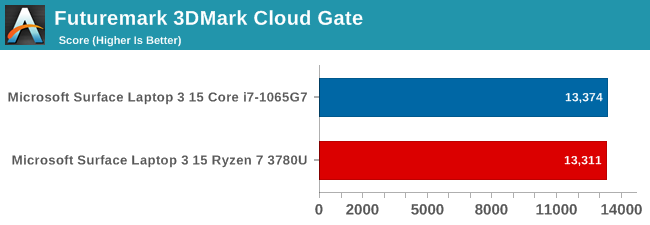
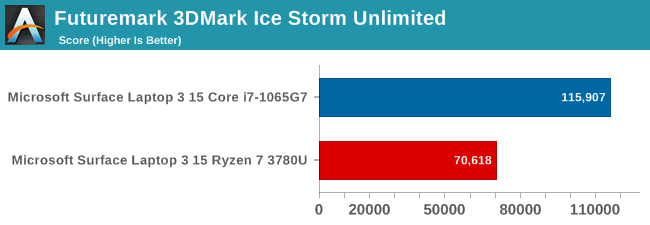
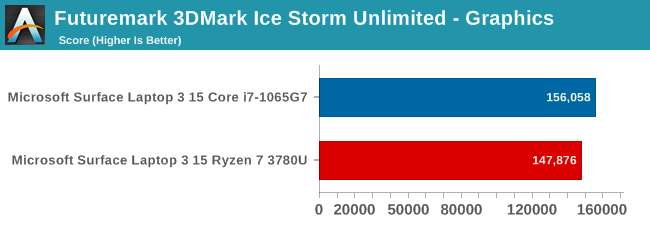
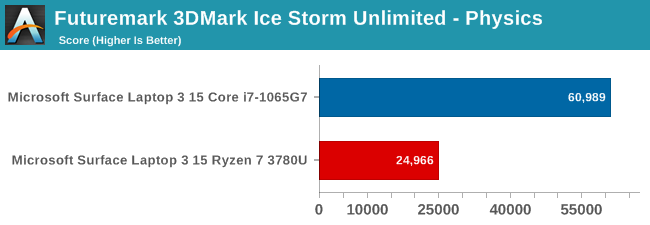
3DMark offers several tests of varying complexity, from Fire Strike as the most demanding, to Ice Storm Unlimited, which can be run on tablets. Here the Ice Lake platform pulls ahead, with better CPU performance helping quite a bit, although the Ice Lake’s Iris Plus graphics is also able to outperform Vega 11 as well.
GFXBench

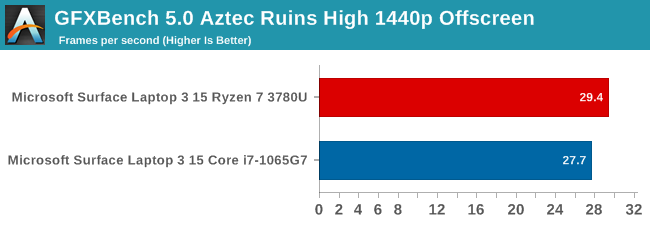
Kishonti’s latest GFXBench suite added DirectX 12 tests to the fold, making it far more relevant than the older OpenGL versions available on the desktop previously. AMD’s previous work in low-level drivers when they developed Mantle has provided the groundwork for DX12 as well, with Vega 11 offering slightly better results than Iris Plus in this test.
Tomb Raider

Running at our value settings, Tomb Raider was easily playable on both systems, with framerates approaching 100 FPS. The Ice Lake platform performed better on this test.
Rise of the Tomb Raider
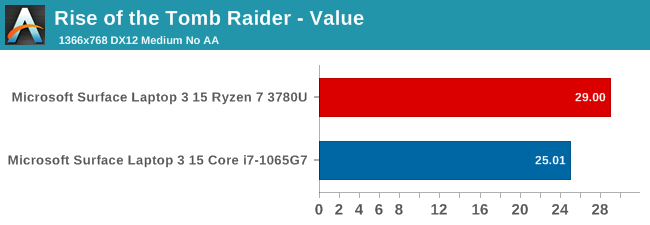
The second installment in the Tomb Raider series offers much more demanding visuals, and both systems struggle to play it at our value settings. The DirectX 12 title performs slightly better on Vega, and with some additional settings tweaks, the game would be playable, which is not something you could have said on an integrated GPU previous to Ryzen and Ice Lake.
Strange Brigade
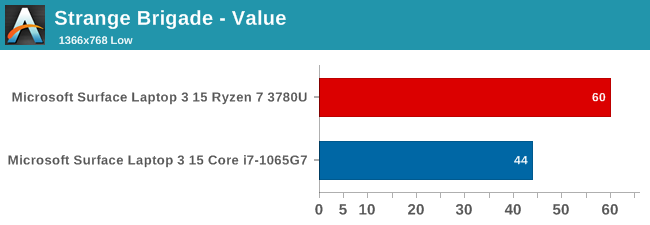
A new title we’re bringing to our laptop suite is Strange Brigade, which scales down nicely on integrated graphics. This game also supports DirectX 12, and as tends to be the pattern, performs very well on Vega 11.
F1 2017
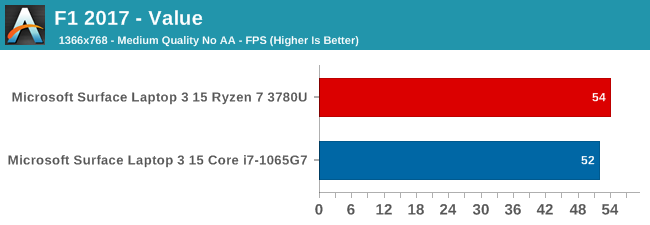
Back with a DirectX 11 title, we see that Intel has again closed the gap, and this game tends to be somewhat CPU bottlenecked as well, so the Sunny Cove cores likely help out here too, but once again Vega 11 wins, if only by a nose.
F1 2019
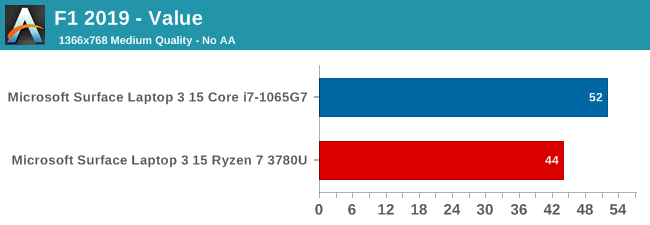
Codemasters updated the underlying EGO engine to support DirectX 12, which was utilized on this test. Despite that, the Vega 11 GPU is a bit slower than the Iris Plus in this test.
Far Cry 5
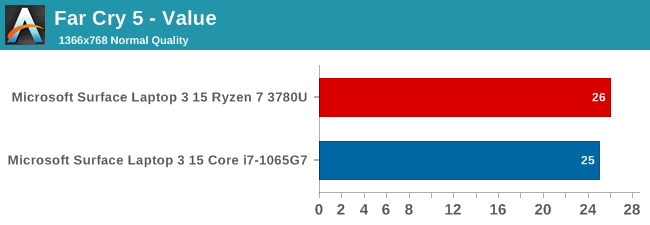
Both systems are within striking distance of being playable, which is somewhat remarkable since the Far Cry series is one of the most popular AAA first-person shooters. The Vega 11 GPU was slightly ahead, which is somewhat surprising as this game tends to be CPU bound, but clearly at this low of a GPU limit that hasn’t come into play yet.










174 Comments
View All Comments
Cliff34 - Saturday, December 14, 2019 - link
I agree. AMD won't be able to compete w Intel until AMD focuses on building cpus for laptops.generalako - Monday, December 16, 2019 - link
Ehhh, Sunny Cove's successor will bring an equal IPC increase, from what Intel has stated.AMD has themselves to blame. Why tf would you delay the architecture of both GPU and CPU and process node as well like that? I mean, the money lost from doing that, as OEMs will have little reason to move away from Intel's superior products, outweighs the money "saved" from this delay, no? Not like a Zen 2 APU won't come anyway, so why not do it before rather than after?
If AMD are smart they'll jump one architecture ahead. Starting with Zen 4 in 1.5 year's time, they should be smart enough to jump straight from Zen 2 APU to Zen 4.
Korguz - Monday, December 16, 2019 - link
generalako " Ehhh, Sunny Cove's successor will bring an equal IPC increase, from what Intel has stated. " and you believe intel ???cheshirster - Tuesday, December 31, 2019 - link
"Sunny Cove's successor will bring an equal IPC increase, from what Intel has stated"They never stated that.
Qasar - Wednesday, January 1, 2020 - link
heh... yea right.. until its proven, just another lie from intel to keep their investors and shareholders happy....azazel1024 - Monday, December 16, 2019 - link
I don't think it is just the IPC boost. The two chips in the comparison here had memory bandwidth differences of 80%!Simply looking at a few of the SPEC INT tests, that was very clear that if AMD even on Zen had similar memory bandwidth to the Ice Lake chip, it likely would have been spitting distance. GPU workloads are also very heavily memory bandwidth constrained and AMD's Vega here was slightly ahead of Intel. If it had 80% higher memory bandwidth it probably would have been 20-30% faster in many of those games/benchmarks.
Even some of the not heavily memory constrained workloads like Handbrake, faster memory does improve performance. That 80% memory bandwidth difference may well have been a 5-8% performance hit to AMD.
BUT AMD shipped it with only DDR4-2400 support. It is the chip they brought to the fight.
If their Zen 2 manages to both have lower platform power (doesn't need to be parity with Intel or better, but 10% better would go a huge long way towards making it less of a decision for a lot of people), brings its 15% better IPC and if it keeps its clock speeds AND manages to bring DDR4L-3000/DDR4x-3760 or whatever compatibility and suspect Intel is done for in the laptop space.
That should give AMD several more wins in CPU performance, bring it to parity or near parity in most of the others leaving Intel with only a few wins in that. For GPU performance, AMD wouldn't even really need to update the iGPU. Just give it that extra bandwidth and Zen 2 CPU behind it and it likely would be kicking Intel's butt by 20-40%. Upgraded on top of having that, yes please.
qap - Saturday, December 14, 2019 - link
I don't think it is about IPC or CPU power anymore. Yes, AMD is slower, but not in a way that would bother me. It is more about power management that is and always was sore spot of AMD in notebooks.And no - 7nm is not the solution unfortunately. It may help under load, but under standby it can actually hurt battery life (leakage is higher). Most improvements in battery life are done by architectural changes (more specialized units, powering down unused parts etc).
nico_mach - Tuesday, December 17, 2019 - link
Well, this driver is still under development and in the first test, they were running cooler than Intel, so likely there is tuning to be done, still. They just haven't done much laptop work in recent years. They're going to be behind on more than the hardware, which is why Microsoft's involvement is really promising, really. Of course they still have some minor hardware matters to sort out, as you point out.Rezurecta - Friday, December 13, 2019 - link
Do you think a lot of help came from the sizeable memory speed differences? Do you think it benefitted cpu or gpu more? Is there a way to underclock the Intel memory so you can see the differences that the memory brings?Thank you.
ikjadoon - Friday, December 13, 2019 - link
It's perplexing: AMD created an entirely new SKU for Microsoft (the AMD RYZEN™ 7 3780U Microsoft Surface® Edition Processor), but AMD still left this CU 11-equipped iGPU at the barebones 2400 MHz speed.Why not rate this MS-only SKU at 2933MHz or 3200MHz? My only thought: high-speed DDR4 was just going to exacerbate AMD's already-too-large power consumption.